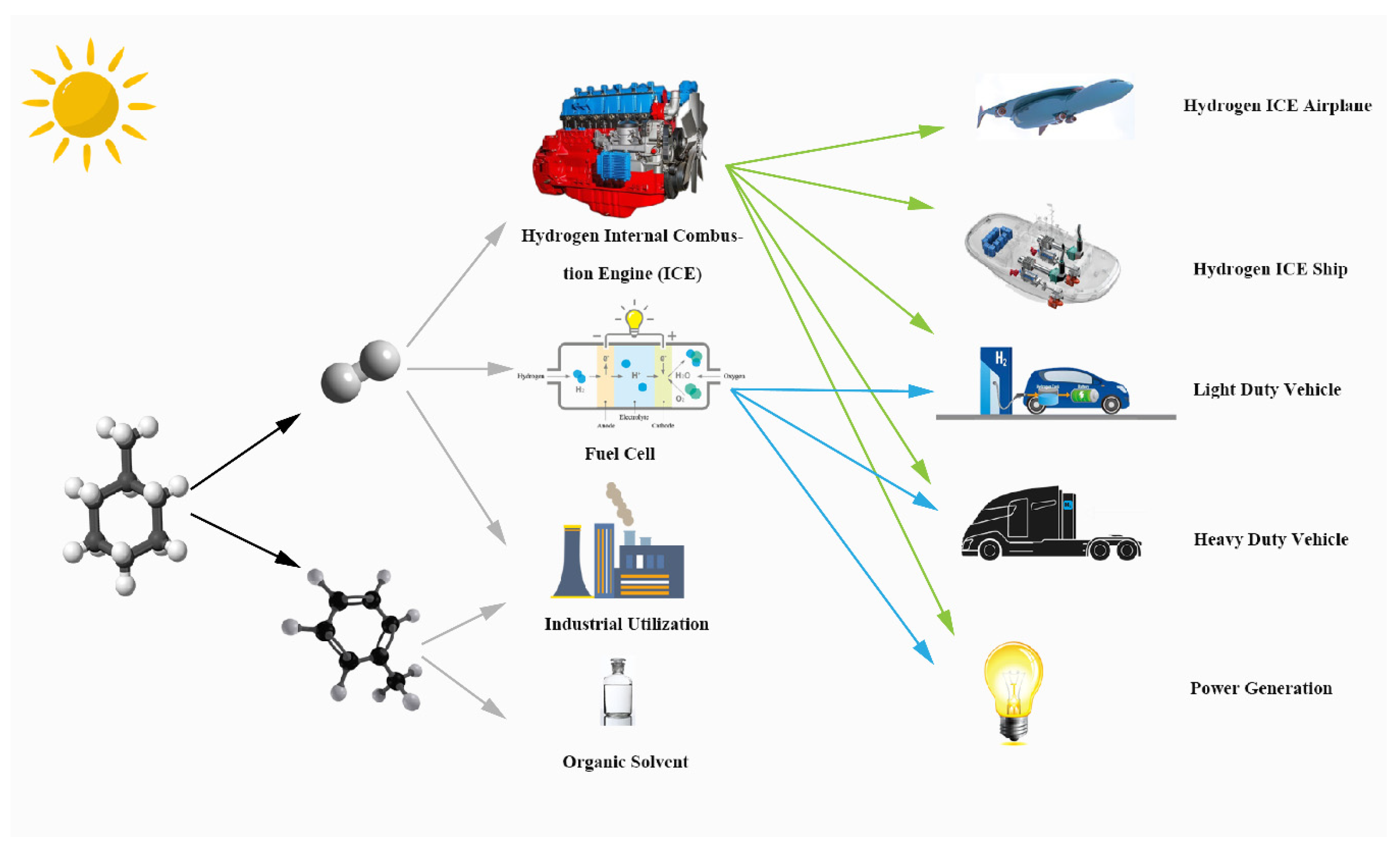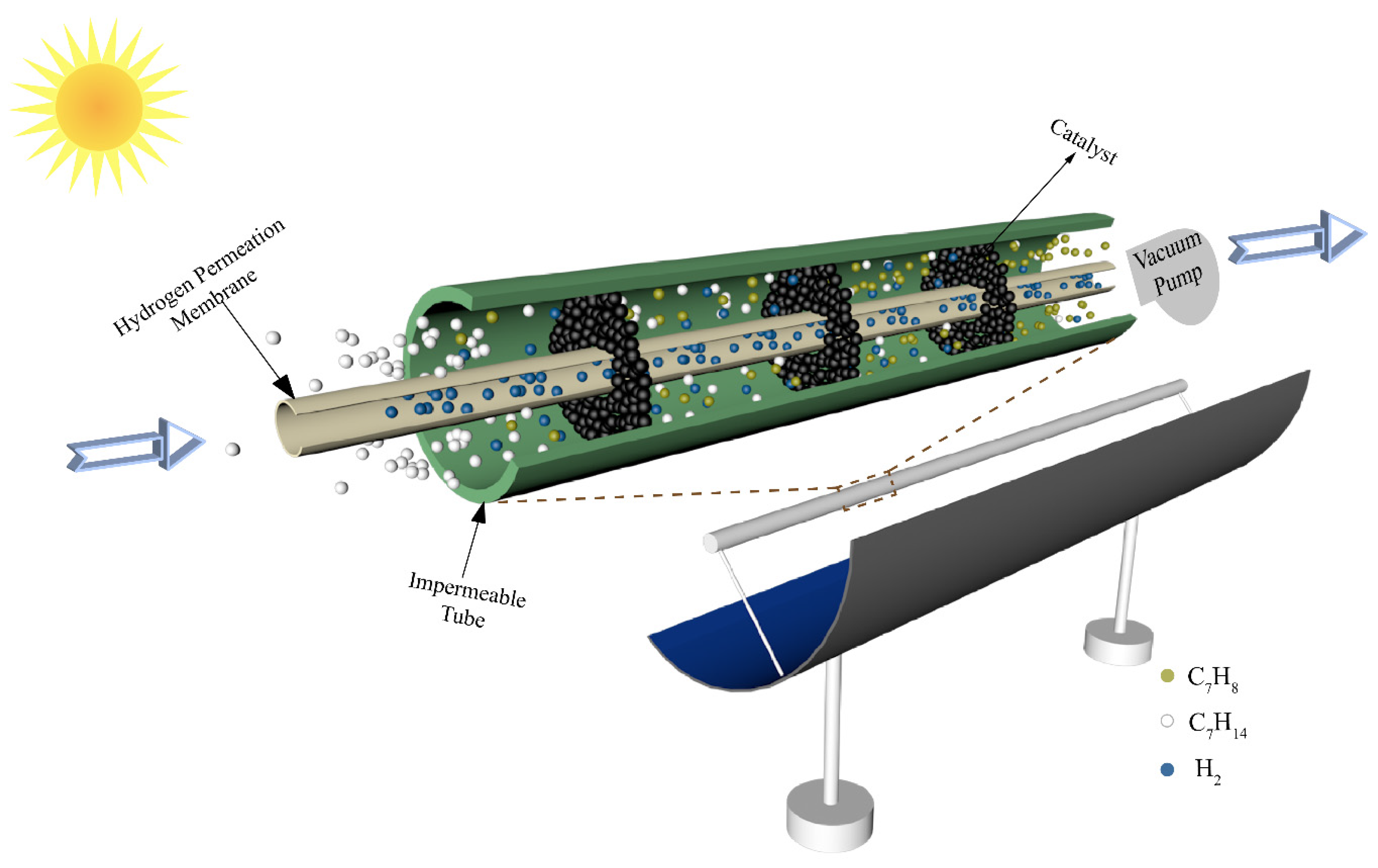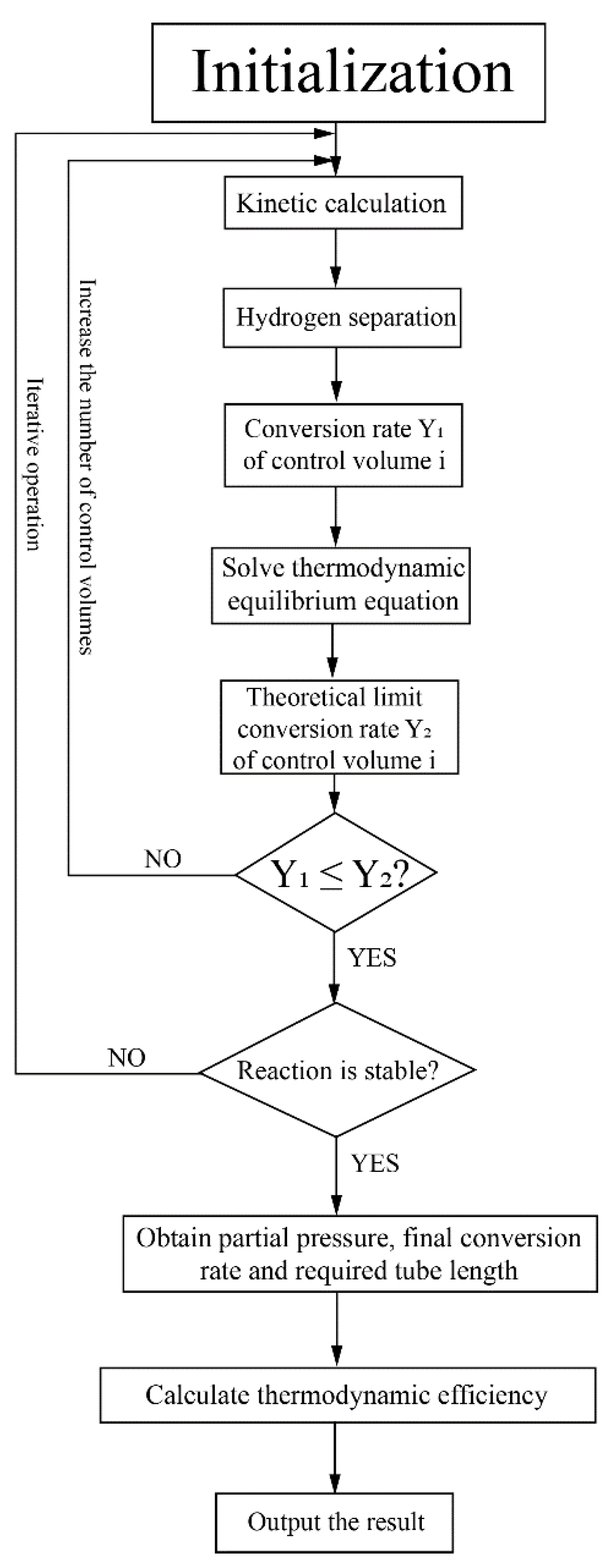Thermodynamic Analysis of Methylcyclohexane Dehydrogenation and Solar Energy Storage via Solar-Driven Hydrogen Permeation Membrane Reactor
Abstract
1. Introduction
2. System Description
3. Theoretical Formulation
Environmental Performance Calculation
4. Results and Discussion
4.1. Conversion Rate
4.2. Thermodynamic Efficiency Analyses
4.3. Environmental Performance
5. Conclusions
- (1)
- The conversion rate of MCH dehydrogenation with the assist of the HPM reactor can be improved, which can reach as high as 99.7% under 200 °C, 0.01 bar, compared to 8.65% in a traditional reactor without hydrogen separation at 200 °C.
- (2)
- This novel system can efficiently utilize solar energy. The first-law of thermodynamic efficiency, solar-to-fuel efficiency, and exergy efficiency can reach 95.58%, 38.65%, and 94.22%, respectively. With a compressor to increase the partial pressure difference of hydrogen, the efficiencies can be improved due to the relatively high mechanical efficiency of the compressor compared with that of a vacuum pump.
- (3)
- This is an environmentally friendly system, and it can save fossil fuels and reduce the emission of carbon dioxide. The SCSR and CDRR can be 25.73 and 63.03 g·m−2 ·h−1 at 350 °C 0.01 bar.
Author Contributions
Funding
Conflicts of Interest
Nomenclature
| B | dimensionless activation energy of adsorption for lumped equilibrium constant |
| B’ | dimensionless heat of adsorption for lumped equilibrium constant |
| Cp | specific heat capacity (kJ/(mol K)) |
| dM | thickness of membrane (m) |
| E | activation energy (J/mol) |
| Ex | exergy (kJ/mol) |
| HHV | molar higher heating value (kJ/mol) |
| ΔH | enthalpy change (kJ/mol) |
| lumped heat of adsorption (kJ/mol) | |
| J | hydrogen permeation flux (mol/m2/s) |
| K | equilibrium constant of the MCH dehydrogenation reaction |
| K’ | lumped equilibrium constant at reaction temperature |
| Kr’ | lumped equilibrium constant at reference temperature |
| KA | adsorption equilibrium constant of MCH (bar−1) |
| KB | adsorption equilibrium constant of TOL (bar−1) |
| KC | adsorption equilibrium constant of hydrogen (bar−1) |
| kd | apparent short-term deactivation constant (day−1) |
| k | rate constant at the reaction temperature (mol/g/s) |
| kr | rate constant at the reference temperature (mol/g/s) |
| P | pressure (bar) |
| P0 | atmosphere pressure (bar) |
| Pr | reaction pressure (bar) |
| pA | partial pressure of MCH (bar) |
| pB | partial pressure of TOL (bar) |
| pC | partial pressure of hydrogen (bar) |
| Qpreheat | solar thermal energy input for raising the temperature of reactant (kJ) |
| Qenthalpy | solar thermal energy input for enthalpy change (kJ) |
| Qsh | thermal energy contained in gases after reaction (kJ) |
| R | universal gas constant (J/(mol K)) |
| Rin | inner radius (cm) |
| Ro | outer radius (cm) |
| r | kinetic rate of the reaction (mol/g/s) |
| T0 | room temperature (K) |
| TH | reaction temperature (K) |
| Tr | reference temperature (K) |
| Tsun | surface temperature of sun (K) |
| td | online reaction deactivation time (day) |
| exergy consumed by vacuum pump to separate hydrogen (kJ) | |
| exergy consumed by compressor to feed MCH into reactor (kJ) | |
| qcoal | heating value of standard coal (kJ/kg) |
| Greek symbols | |
| μ | mass ratio of carbon dioxide emission from standard coal combustion (–) |
| α | conversion rate of methane (–) |
| ηc→e | conversion efficiency from standard coal to electricity (–) |
| ηc→h | conversion efficiency from standard coal to heat (–) |
| ηHHV | First-law of thermodynamic efficiency with separation exergy (–) |
| ηHHV,real | First-law of thermodynamic efficiency with real separation energy (–) |
| ηs→f | Solar-to-fuel efficiency with separation exergy (–) |
| ηs→f,real | Solar-to-fuel efficiency with real separation energy (–) |
| ηex | exergy efficiency (–) |
| ηabs | absorption efficiency (–) |
| ηopt | optical efficiency (–) |
| vacuum pump efficiency (–) | |
| compressor mechanical efficiency (–) | |
| ηs→e | Solar-to-electricity efficiency (–) |
| Superscript | |
| standard state | |
| * | active sites of catalyst |
| Subscripts | |
| d | day |
| in | input, inside |
| init | initial |
| opt | optical |
| out | output, outside |
| p | vacuum pump/compressor |
| res | residual gas |
Appendix A
| Parameter | Value | Units |
|---|---|---|
| kr × 105 | 4.066 ± 0.44 | mol g−1 s−1 |
| B | 7.65 ± 0.10 | – |
| KA | 40.9 ± 10.5 | bar−1 |
| KB | 22.2 ± 7.05 | bar−1 |
| Kr′ | 6.69 ± 1.43 | bar−3 |
| B′ | −24.0 ± 3.14 | – |
| −123.4 | kJ mol−1 | |
| kd | 1.47 ± 0.17 | day−1 |
References
- Yilmaz, F.; Balta, M.T.; Selbaş, R. A review of solar based hydrogen production methods. Renew. Sustain. Energy Rev. 2016, 56, 171–178. [Google Scholar] [CrossRef]
- Li, W.J.; Wang, H.S.; Hao, Y. A PVTC system integrating photon-enhanced thermionic emission and methane reforming for efficient solar power generation. Sci. Bull. 2017, 62, 1380–1387. [Google Scholar] [CrossRef]
- Bockris, J.O.M. The hydrogen economy: Its history. Int. J. Hydrog. Energy 2013, 38, 2579–2588. [Google Scholar] [CrossRef]
- Moradi, R.; Groth, K.M. Hydrogen storage and delivery: Review of the state of the art technologies and risk and reliability analysis. Int. J. Hydrog. Energy 2019, 44, 12254–12269. [Google Scholar] [CrossRef]
- White, C.; Steeper, R.; Lutz, A. The hydrogen-fueled internal combustion engine: A technical review. Int. J. Hydrog. Energy 2006, 31, 1292–1305. [Google Scholar] [CrossRef]
- Teichmann, D.; Arlt, W.; Wasserscheid, P. Liquid Organic Hydrogen Carriers as an efficient vector for the transport and storage of renewable energy. Int. J. Hydrog. Energy 2012, 37, 18118–18132. [Google Scholar] [CrossRef]
- Oda, K.; Akamatsu, K.; Sugawara, T.; Kikuchi, R.; Segawa, A.; Nakao, S. Dehydrogenation of Methylcyclohexane to Produce High-Purity Hydrogen Using Membrane Reactors with Amorphous Silica Membranes. Ind. Eng. Chem. Res. 2010, 49, 11287–11293. [Google Scholar] [CrossRef]
- Wang, X.C.; Wang, B.Z.; Wang, M.; Liu, Q.J.; Wang, H.S. Cyclohexane dehydrogenation in solar-driven hydrogen permeation membrane reactor for efficient solar energy conversion and storage. J. Therm. Sci. 2020. [Google Scholar] [CrossRef]
- Amirabadi, S.; Kabiri, S.; Vakili, R.; Iranshahi, D.; Rahimpour, M.R. Differential Evolution Strategy for Optimization of Hydrogen Production via Coupling of Methylcyclohexane Dehydrogenation Reaction and Methanol Synthesis Process in a Thermally Coupled Double Membrane Reactor. Ind. Eng. Chem. Res. 2013, 52, 1508–1522. [Google Scholar] [CrossRef]
- Niimi, T.; Nagasawa, H.; Kanezashi, M.; Yoshioka, T.; Ito, K.; Tsuru, T. Preparation of BTESE-derived organosilica membranes for catalytic membrane reactors of methylcyclohexane dehydrogenation. J. Membr. Sci. 2014, 455, 375–383. [Google Scholar] [CrossRef]
- Ali, J.K.; Newson, E.J.; Rippin, D.W.T. Exceeding equilibrium conversion with a catalytic membrane reactor for the dehydrogenation of methylcyclohexane. Chem. Eng. Sci. 1994, 49, 2129–2134. [Google Scholar] [CrossRef]
- Meng, L.; Yu, X.; Niimi, T.; Nagasawa, H.; Kanezashi, M.; Yoshioka, T.; Tsuru, T. Methylcyclohexane dehydrogenation for hydrogen production via a bimodal catalytic membrane reactor. AIChE J. 2015, 61, 1628–1638. [Google Scholar] [CrossRef]
- Cholewa, M.; Zehner, B.; Kreuder, H.; Pfeifer, P. Optimization of membrane area to catalyst mass in a microstructured membrane reactor for dehydrogenation of methylcyclohexane. Chem. Eng. Process. Process Intensif. 2018, 125, 325–333. [Google Scholar] [CrossRef]
- Dahlmeyer, J.; Garrison, T.; Garrison, T.; Darkey, S.; Massicotte, F.; Rebeiz, K.; Nesbit, S.; Craft, A. Effects of hydrogen exposure temperature on the tensile strength, microhardness and ductility of Pd/Ag (25 wt.%) alloy. Scr. Mater. 2011, 64, 789–792. [Google Scholar] [CrossRef]
- Yun, S.; Oyama, S.T. Correlations in palladium membranes for hydrogen separation: A review. J. Membr. Sci. 2011, 375, 28–45. [Google Scholar] [CrossRef]
- Pal, N.; Agarwal, M.; Maheshwari, K.; Solanki, Y.S. A review on types, fabrication and support material of hydrogen separation membrane. Mater. Today Proc. 2020, 28, 1386–1391. [Google Scholar] [CrossRef]
- Kreuder, H.; Boeltken, T.; Cholewa, M.; Meier, J.; Pfeifer, P.; Dittmeyer, R. Heat storage by the dehydrogenation of methylcyclohexane—Experimental studies for the design of a microstructured membrane reactor. Int. J. Hydrog. Energy 2016, 41, 12082–12092. [Google Scholar] [CrossRef]
- Ferreira-Aparicio, P.; Rodriguez-Ramos, I.; Guerrero-Ruiz, A. On the Performance of Porous Vycor Membranes for Conversion Enhancement in the Dehydrogenation of Methylcyclohexane to Toluene. J. Catal. 2002, 212, 182–192. [Google Scholar] [CrossRef]
- Kreuder, H.; Müller, C.; Meier, J.; Gerhards, U.; Dittmeyer, R.; Pfeifer, P. Catalyst development for the dehydrogenation of MCH in a microstructured membrane reactor—For heat storage by a Liquid Organic Reaction Cycle. Catal. Today 2015, 242, 211–220. [Google Scholar] [CrossRef]
- Porzio, G.F.; Colla, V.; Matarese, N.; Nastasi, G.; Branca, T.A.; Amato, A.; Fornai, B.; Vannucci, M.; Bergamasco, M. Process integration in energy and carbon intensive industries: An example of exploitation of optimization techniques and decision support. Appl. Therm. Eng. 2014, 70, 1148–1155. [Google Scholar] [CrossRef]
- Kong, H.; Kong, X.H.; Wang, H.S.; Wang, J. A strategy for optimizing efficiencies of solar thermochemical fuel production based on nonstoichiometric oxides. Int. J. Hydrog. Energy 2019, 44, 19585–19594. [Google Scholar] [CrossRef]
- Wang, B.Z.; Kong, H.; Wang, H.S.; Wang, Y.P.; Hu, X.J. Kinetic and thermodynamic analyses of mid/low-temperature ammonia decomposition in solar-driven hydrogen permeation membrane reactor. Int. J. Hydrog. Energy 2019, 44, 26874–26887. [Google Scholar] [CrossRef]
- Hong, H.; Jin, H.; Ji, J.; Wang, Z.; Cai, R. Solar thermal power cycle with integration of methanol decomposition and middle-temperature solar thermal energy. Sol. Energy 2005, 78, 49–58. [Google Scholar] [CrossRef]
- Adrian, M.H.; Wenzel, S.; Youssef, F. Advanced propane dehydrogenation. Pet. Technol. Q. 2008, 13, 83–91. [Google Scholar]
- Sun, J.; Liu, Q.B.; Hong, H. Numerical study of parabolic-trough direct steam generation loop in recirculation mode: Characteristics, performance and general operation strategy. Energy Convers. Manag. 2015, 96, 287–302. [Google Scholar] [CrossRef]
- Kalogirou, S.A. Solar thermal collectors and applications. Prog. Energy Combust. Sci. 2004, 30, 231–295. [Google Scholar] [CrossRef]
- Mills, D. Advances in solar thermal electricity technology. Sol. Energy 2004, 76, 19–31. [Google Scholar] [CrossRef]
- Wang, H.S.; Liu, M.K.; Kong, H.; Hao, Y. Thermodynamic analysis on mid/low temperature solar methane steam reforming with hydrogen permeation membrane reactors. Appl. Therm. Eng. 2019, 152, 925–936. [Google Scholar] [CrossRef]
- Wang, H.S.; Hao, Y.; Kong, H. Thermodynamic study on solar thermochemical fuel production with oxygen permeation membrane reactors. Int. J. Energy Res. 2015, 39, 1790–1799. [Google Scholar] [CrossRef]
- Roine, A. HSC Chemistry 5.11; Outokumpu Research Oy: Pori, Finland, 2001–2002. [Google Scholar]
- Wang, H.S.; Li, W.J.; Liu, T.; Liu, X.; Hu, X.J. Thermodynamic analysis and optimization of photovoltaic/thermal hybrid hydrogen generation system based on complementary combination of photovoltaic cells and proton exchange membrane electrolyzer. Energy Convers. Manag. 2019, 183, 97–108. [Google Scholar] [CrossRef]
- Jarrett, C.; Chueh, W.; Yuan, C.; Kawajiri, Y.; Sandhage, K.H.; Henry, A. Critical limitations on the efficiency of two-step thermochemical cycles. Sol. Energy 2016, 123, 57–73. [Google Scholar] [CrossRef]
- Bulfin, B.; Call, F.; Lange, M.; Lübben, O.; Sattler, C.; Pitz–Paal, R.; Shvets, I.V. Thermodynamics of CeO2 thermochemical fuel production. Energy Fuel 2015, 29, 1001–1009. [Google Scholar] [CrossRef]
- Abid, M.; Ratlamwala, T.A.H.; Atiko, U. Performance assessment of parabolic dish and parabolic trough solar thermal power plant using nanofluids and molten salts. Int. J. Energy Res. 2016, 40, 550–563. [Google Scholar] [CrossRef]
- Wang, H.; Wang, B.; Qi, X.; Wang, J.; Yang, R.; Li, D.; Hu, X. Innovative non–oxidative methane dehydroaromatization via solar membrane reactor. Energy 2020, 119265. [Google Scholar] [CrossRef]
- Wang, H.S.; Kong, H.; Pu, Z.G.; Li, Y.; Hu, X.J. Feasibility of high efficient solar hydrogen generation system integrating photovoltaic cell/photon-enhanced thermionic emission and high-temperature electrolysis cell. Energy Convers. Manag. 2020, 210, 112699. [Google Scholar] [CrossRef]
- Tu, H.; Liu, C. Calculation of CO2 emission of standard coal. Coal Qual. Technol. 2014, 2, 57–60. [Google Scholar]
- Fletcher, E.A. Solar thermal processing: A review. J. Sol. Energy Eng. 2001, 123, 63–74. [Google Scholar] [CrossRef]
- System Advisor Model, Version 2016.3.14. Available online: https://sam.nrel.gov/ (accessed on 27 November 2020).
- Usman, M.; Cresswell, D.; Garforth, A. Detailed Reaction Kinetics for the Dehydrogenation of Methylcyclohexane over Pt Catalyst. Ind. Eng. Chem. Res. 2011, 51, 158–170. [Google Scholar] [CrossRef]
- Usman, M.R. Kinetics of Methylcyclohexane Dehydrogenation and Reactor Simulation for “On–board” Hydrogen Storage. Ph.D. Thesis, The University of Manchester, Manchester, UK, 2010. [Google Scholar]
- Akram, M.S.; Aslam, R.; Alhumaidan, F.S.; Usman, M.R. An exclusive kinetic model for the methylcyclohexane dehydrogenation over alumina-supported Pt catalysts. Int. J. Chem. Kinet. 2020, 52, 415–449. [Google Scholar] [CrossRef]
- Morreale, B.D.; Ciocco, M.V.; Enick, R.M.; Morsi, B.I.; Howard, B.H.; Cugini, A.V.; Rothenberger, K.S. The permeability of hydrogen in bulk palladium at elevated temperatures and pressures. J. Membr. Sci. 2003, 212, 87–97. [Google Scholar] [CrossRef]












Publisher’s Note: MDPI stays neutral with regard to jurisdictional claims in published maps and institutional affiliations. |
© 2020 by the authors. Licensee MDPI, Basel, Switzerland. This article is an open access article distributed under the terms and conditions of the Creative Commons Attribution (CC BY) license (http://creativecommons.org/licenses/by/4.0/).
Share and Cite
Wang, H.; Wang, B.; Kong, H.; Lu, X.; Hu, X. Thermodynamic Analysis of Methylcyclohexane Dehydrogenation and Solar Energy Storage via Solar-Driven Hydrogen Permeation Membrane Reactor. Membranes 2020, 10, 374. https://doi.org/10.3390/membranes10120374
Wang H, Wang B, Kong H, Lu X, Hu X. Thermodynamic Analysis of Methylcyclohexane Dehydrogenation and Solar Energy Storage via Solar-Driven Hydrogen Permeation Membrane Reactor. Membranes. 2020; 10(12):374. https://doi.org/10.3390/membranes10120374
Chicago/Turabian StyleWang, Hongsheng, Bingzheng Wang, Hui Kong, Xiaofei Lu, and Xuejiao Hu. 2020. "Thermodynamic Analysis of Methylcyclohexane Dehydrogenation and Solar Energy Storage via Solar-Driven Hydrogen Permeation Membrane Reactor" Membranes 10, no. 12: 374. https://doi.org/10.3390/membranes10120374
APA StyleWang, H., Wang, B., Kong, H., Lu, X., & Hu, X. (2020). Thermodynamic Analysis of Methylcyclohexane Dehydrogenation and Solar Energy Storage via Solar-Driven Hydrogen Permeation Membrane Reactor. Membranes, 10(12), 374. https://doi.org/10.3390/membranes10120374








